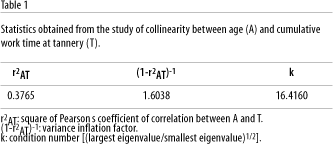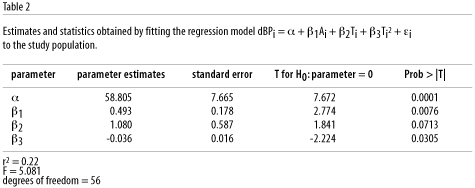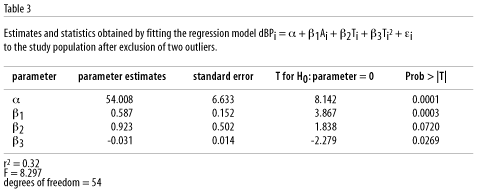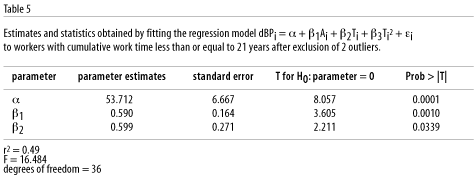| Ricardo Cordeiro 1 Euclydes Custódio de Lima Filho 2 | Association between diastolic blood pressure and cumulative work time Associação entre pressão diastólica e tempo de serviço
|
| 1 Departamento de Saúde Pública, Universidade Estadual Paulista. C. P. 543, Botucatu, SP 18618-970, Brazil. cordeiro@fmb.unesp.br 2 Departamento de Educação Motora, Universidade Estadual de Campinas. C. P. 6134, Campinas, SP 13083-970, Brazil. euclydes@fef.unicamp.br
| Abstract Diastolic blood pressure was viewed as a generic indicator of aging, and its association with cumulative work time was studied after controlling for age as a potential confounding factor. The study was conducted among production line workers at a Brazilian tannery in July 1993. The association between diastolic blood pressure and cumulative work time was verified by fitting a second-order linear regression model, where diastolic blood pressure was a function of worker's age and cumulative work time. By fitting the model, one can predict that, in the beginning of working life at the tannery, on average each 1-year period is associated with an increase of about 1.5 mmHg in diastolic blood pressure. The fit obtained highlights one component directly associated with work as part of the rate of pressure increase in the study group. This component is twice as high as that directly associated with age. Key words Blood Pressure; Hypertension; Aging; Occupational Health Resumo A pressão arterial diastólica foi analisada enquanto indicador genérico de envelhecimento, e sua associação com o tempo de serviço foi estudada após o controle da idade como possível fator de confundimento. O estudo foi realizado entre operários de um curtume brasileiro em julho de 1993. Foi testada a associação entre pressão diastólica e tempo de serviço, ajustando um modelo de regressão linear de segunda ordem, em que a pressão diastólica era função da idade e do tempo de serviço do operário. Ao ajustar o modelo, pode-se prever que, no início do trabalho no curtume, em média, cada período de um ano está associado com um aumento de cerca de 1,5 mmHg na pressão diastólica. O ajuste obtido realça um componente diretamente associado ao trabalho como parte do coeficiente de aumento da pressão no grupo estudado. Esse componente é o dobro daquele diretamente associado com a idade. |
Introduction
Cardiovascular diseases have been identified as the first cause of death among workers in Brazil since the 1970s. High blood pressure has been the main risk factor among these diseases. An inverse relationship between occupational qualification and blood pressure has been observed among Brazilian workers (Cordeiro et al., 1993). That is to say that the highest prevalence of high blood pressure is found among unskilled industrial workers with the heaviest work loads and the lowest incomes. This correlation suggests that blood pressure may be an indicator of physical wear and tear and aging among industrial workers. The aim of the present research was to further the study of work-related wear and tear and aging among Brazilian workers. Diastolic blood pressure was viewed as a generic indicator of aging, and its association with cumulative work time was studied after controlling age as a confounding factor.
Subjects and methods
The research was conducted studying all of the 57 active production line workers at a tannery in Botucatu, in the State of São Paulo, Brazil, in July 1993. The factory produces leather from cattle hides through a low-technology chemical process using synthetic tanning. These workers had already been analyzed in a cross-sectional study (Cordeiro et al., 1998), displaying a high prevalence of arterial hypertension. We also presented details on the tannery workers' smoking, alcohol intake, body mass index, and income and a comparison of their blood pressure levels to those of other occupational groups in Brazil (Cordeiro et al., 1998).
For the present study, the workers underwent an occupational history and blood pressure measurements. Blood pressure (BP) was measured in the morning. After a 30-minute rest period in a silent waiting room, three readings were taken with intervals of at least 15 minutes. Measurements were performed on the right arm with the individual in a sitting position in all cases.
A fully calibrated Takaoka Model 203 mercury gauge sphygmomanometer with a 26cm x 12cm arm cuff and a clinical stethoscope were used for all BP measurements. Two hours before the first measurement the workers were asked to empty their bladders. They were also asked not to smoke or drink coffee or any other stimulant beverage from this moment until the tests had been completed. Blood pressure measurements were made by the same fully trained orderly. To measure blood pressure, the arm cuff was inflated rapidly until the sphygmomanometer reached 200 mmHg. If, at this point, there were audible Korotkow sounds, the arm cuff was further inflated to 260 mmHg. The arm cuff was then slowly deflated. The systolic and diastolic blood pressure measurements corresponded to the reading on the sphygmomanometer at the first and fifth phases of the Korotkow sounds, respectively. The scale on the sphygmomanometer was graduated in 2 millimeter divisions. The readings were made to the nearest millimeter. The lowest of the three diastolic blood pressure readings was used in the analysis. Cumulative work time at the tannery was directly assessed by interviews with the study group and later ratified by consultation in the company's administrative files.
The study of the association between diastolic blood pressure and cumulative work time was performed by fitting a complete second-order linear regression model, where diastolic blood pressure was a function of the independent variables worker's age and cumulative work time, as shown in the equation below:

where 'A' stands for worker's age and 'T' stands for worker's cumulative time at the tannery. The cosine of the angle between the sample vectors A and T was used as an estimate of collinearity between worker's age and cumulative work time in the study group. This angle was evaluated using the coefficient of sample correlation (r2AT), and the variance inflation factor [(1-r2AT)-1] (Weisberg, 1985). The condition number k [(largest eigenvalue/smallest eigenvalue)1/2] (Wetheril, 1986) was also used as additional information. These analyses were justified due to the possibility of correlation between the worker's age and cumulative work time in a given group of workers, making the proposed fit difficult (Belsley, 1991).
Calculations were performed using the CORR and REG procedures of the SAS for Windows 6.12 software.
Results
Figures 1, 2, and 3 show, respectively, diastolic blood pressure, worker's age, and cumulative work time distributions for the study group.
Table 1 shows the statistics obtained from the study of collinearity between the variables worker's age and cumulative work time.

Upon fitting the model represented in equation (1) by the stepwise method, we observed that the coefficients ß3 and ß5 presented a significance level higher than 0.15. Thus, the terms were excluded from the model, which becomes:
were excluded from the model, which becomes:

Table 2 shows the statistics obtained by fitting this reduced model.

Figures 4, 5, and 6 show the joint distribution of residuals of the fitted regression (equation 2), and predicted value, worker's age, and cumulative work time, respectively.
Table 3 shows the statistics obtained by fitting equation (2) when applied to the study group data after exclusion of two workers whose blood pressure values were considered outliers, as discussed below.

Discussion
Studying the association between blood pressure and cumulative work time is usually difficult due to the problems of controlling age confounding using multiple regression. This fact is due to the collinearity that usually exists between the variables worker's age and cumulative work time, which increases the variance of estimates obtained with regression models. However, in this particular set of data, collinearity was not important as shown by the statistics in Table 1. This occurred because, although members of the study group were long-term employees, the age at which they began work at the tannery varied greatly, as shown in Figure 7. For this reason, the study group presented a great number of older workers with shorter cumulative work times.
It is important to note that when fitting the model (1), the high p-value associated with the term ß5AiTi may be partially due to the relatively small number of subjects studied.
The fit of the final model revealed an association between diastolic blood pressure and cumulative work time, after controlling age confounding, as shown in Table 2.
Two points relating to two workers whose diastolic blood pressure was unusually high were highlighted analyzing figures (4), (5), and (6). We observed that these workers had the first and third highest blood pressure values of the group, with relatively low age and short cumulative work time. After anamnesis, the two workers were found to have family histories of high blood pressure and were excluded from the analysis. Upon readjusting the model after this exclusion, a better fit was obtained, as shown by the comparison between Tables 2 and 3. By refitting the model after the exclusion of the two outliers, one can predict the diastolic blood pressure of the study group, according to the equation below (Table 3):

Thus, from the readjusted model, we observed that in the study group, in the beginning of working life at the tannery, each 1-year period is associated with a mean increase of approximately 1.5 mmHg in the diastolic blood pressure. About two thirds of this increase [0.92/(0.92+0.59)] is directly associated with the work quantified by cumulative time at the tannery. In other words, the fit allows us to identify a component directly associated with work as part of the rate of blood pressure increase in the study group. This component is twice as high as that directly associated with age.
Two hypotheses can be proposed to interpret the meaning of the quadratic term of equation (3), -0.03Ti2. The first is that it could be the result of the higher sensitivity of workers to occupational stressors at the beginning of their work life at the tannery, i.e. when they have still not developed defense strategies against the aggression from the new occupation. The second is that some of the older workers with a longer cumulative work time at the tannery may be leaving their jobs due to complications caused by high blood pressure, a hypothesis related to the healthy work effect (McMichael, 1975). In this case, the quadratic term would be the result of a limitation of the study design.
The second of these two hypotheses is corroborated by achieving a good fit of the simplified model below (without the quadratic term),

when applied to a subset of the study group consisting of workers with shorter cumulative work times.
Table 4 shows the study of collinearity between age and cumulative work time applied to those workers whose cumulative work time was less than or equal to 21 years, and after the exclusion of the two outliers previously mentioned. Table 5 shows the simplified model (4) applied to this same subgroup. A better fit is obtained in comparison to that previously obtained (equation 2), with a relatively high r2 value, as shown in Table 5. This 21-year cut-off point which optimizes the fit of the model was an accidental finding. Model (4) is well fitted when the cut-off point ranges from 18 to 23 years, achieving its best fit when the value is 21 years.


It is interesting that no association was found between systolic blood pressure and cumulative work time by fitting models similar to model (2) and (4), either in the study group as a whole or in any of its subsets.
Finally, the association between cumulative work time and diastolic blood pressure shown here suggests that cumulative work time acted as a marker of exposure to situations that might cause a higher increase in blood pressure of the workers under study. This would provide a stimulus for the search for both this association in other groups of workers and the causal relations between occupation and diastolic blood pressure.
References
BELSLEY, D. A., 1991. Conditioning Diagnostic Collinearity and Weak Data in Regression. New York: John Wiley & Sons.
CORDEIRO, R.; FISCHER, F. M.; LIMA FILHO, E. C. & MOREIRA FILHO, D. C., 1993. Ocupação e hipertensão. Revista de Saúde Pública, 27:380-387.
CORDEIRO, R.; LIMA FILHO; E. C. & ALMEIDA, I. M., 1998. Pressão arterial entre trabalhadores de um curtume. Revista de Saúde Pública. 32: 467-476.
McMICHAEL, A. J., 1975. Observations on the evaluation of occupational mortality data. Journal of Occupational Medicine, 17:128-131.
WEISBERG, S., 1985. Applied Linear Regression. New York: John Wiley & Sons.
WETHERILL, G. B., 1986. Regression Analysis with Applications. Cambridge: Chapman and Hall.
